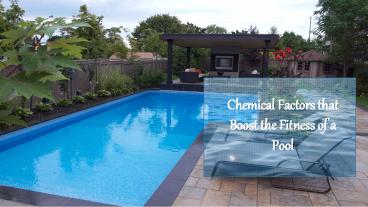Chemical Factors that Boost the Fitness of a Pool - PowerPoint PPT Presentation
Title:
Chemical Factors that Boost the Fitness of a Pool
Description:
The swimming pool is the delightful place of your home where you can spend some quality time with your family. Make sure that the water of your swimming pool should be regularly monitored and sanitized to maintain its freshness and quality. The pool owners often use different chemicals to make their water clean and hygienic, but if the chemical level is not balanced then it may spoil your water and leads to many skin diseases. You can go through the following s to know about the different chemical factors of swimming pool and its basic uses. – PowerPoint PPT presentation
Number of Views:19
Title: Chemical Factors that Boost the Fitness of a Pool
1
Chemical Factors that Boost the Fitness of a Pool
2
The swimming pool is a delightful place to spend
time, where people of all ages can enjoy time
together and achieve fitness goals without
sacrificing their social life.
3
In order to have a healthy outing in your pool,
the quality of water, should be regularly
monitored and sanitized.
4
1
pH balance
2
total alkalinity
3
calcium hardness
There are several chemical factors to determine
the grade of pool water
4
chlorine
5
shock
6
metals
5
1
pH Balance
6
pH is a basic measure of acidic and basic nature
of the pool water.
7
Low pH makes the water corrosive, cause skin
problems and high value results in cloudy water
which effects chlorine.
8
It should be neither more acidic nor alkaline
and should be kept in the range of 7.2-7.6
measure on a scale of 0-14 where the value 7 is
termed neutral.
9
2
Total Alkalinity
10
To maintain proper pH balance, the required
amount of acid buffers or total alkalinity must
be maintained in the pool.
11
The proposed total alkalinity of a pool is
120-150 ppm.
12
Calcium Hardness
3
13
Calcium hardness is the amount of dissolved
calcium in the pool water.
14
The proper range of calcium hardness in pool
water is 200-250 ppm for concrete pools and
175-225 ppm for vinyl pools.
15
Low level of hardness results in plaster finish
etching and degrade the vinyl liners and high
calcium levels lead to deposition of calcium on
the pool surfaces and equipment.
16
4
Chlorine
17
Stabilized chlorine helps to sanitize the water
by killing the algae and bacteria present in the
pool as well as eliminating the diffused grease
and oils.
18
The active chlorine in pool water should be
tested regularly and maintained at an ideal range
of 1-3 ppm.
19
5
Shock
20
A shock treatment is a high concentration of
chlorine, which adds 5-10 ppm of free chlorine to
pool water.
21
It is unstabilized chlorine, which stays in the
water for 12-24 hours and eliminates the organic
waste, kills the pathogens and prevents the
growth of algae.
22
Do not use the pool after shocking until the
chlorine level is below 3 ppm.
23
6
Metals
24
No metals like copper or iron should be allowed
to be present in a swimming pool as they stain
the pool and change the color of the water.
25
A stain and scale remover should be deployed
regularly to prevent staining, and traces of
metal must be removed from the pool.
26
Conclusion
27
Always use the pool chemicals exactly as
directed with required protective equipment and
also follow all precautions for their storage.
28
A clean and clear water is the key to an
enjoyable pool and a healthy body.
29
https//www.beachwoodpools.com/
https//www.facebook.com/pages/ Beachwood-Pools/14
86976741610400
https//www.pinterest.com/beachwoodpool/
THANK YOU!
https//www.youtube.com/channel/ UC8_P0qLHCUbK1b6v
aY7Xmyg































